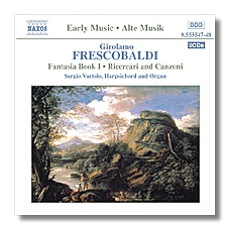
The Internet's Premier Classical Music Source
Related Links
- Frescobaldi Reviews
- Latest Reviews
- More Reviews
-
By Composer
-
Collections
DVD & Blu-ray
Books
Concert Reviews
Articles/Interviews
Software
Audio
Search Amazon
Recommended Links
Site News
 CD Review
CD Review
Girolamo Frescobaldi

Fantasia Book I – Ricercari & Canzoni
- Il Primo Libro delle Fantasie
- Ricercari
- Canzoni Francesi
Sergio Vartolo, harpsichord & organ
Naxos 8.553547-48 DDD 2CDs: 67:15, 64:45
In 1608, Ferrarese composer Girolamo Frescobaldi (1583-1643) was appointed organist to St. Peter's in Rome, a position he retained until his death. For brief periods, he also held posts in Mantua and in Florence, where he served the Medici family. Among his youthful influences, both Luzzaschi and Gesualdo have been noted, and he in turn influenced many later Baroque composers, including no less than Johann Sebastian Bach, who copied Frescobaldi's so-called Fiori musicali, a book of organ masses and other sacred or secular organ works.
The music on these CDs comes from relatively early in Frescobaldi's career. The first book of Fantasie (there was no second book) was published in 1608, and the Ricercari and Canzoni Francesi were published in 1615. There are twelve fantasie, one for each of the twelve modes. The counterpoint becomes increasingly intricate as the set progresses, but Frescobaldi never lets the music devolve into academic dryness. The ten Ricercari are similar in spirit, and dramatically virtuosic in their exploration of what can be done with counterpoint. The five Canzoni Francesi are less rigorous. Here, Frescobaldi fuses several genres together, and here, one feels that the composer's foremost goal was to entertain, and only secondarily to instruct and amaze.
With this CD, Sergio Vartolo concludes his series of the complete keyboard works of Frescobaldi. (Earlier releases have been on the Tactus label.) Vartolo has held academic posts in Bologna and in Venice, where he currently teaches at the Conservatory. His scholarly booklet notes contribute much to the present release. However, of course it is his playing that really matters. Vartolo leads the listener through the composer's contrapuntal thickets like a friendly tour-guide, gifted with historical know-how, recreative imagination, and fingers that are both calm and confident. For timbral variety, he leaves behind his harpsichord in two of the Fantasie, three of the Ricercari, and two of the Canzoni Francesi, turning instead to the sweet-toned organ in the Church of the Holy Spirit in Pistoia. (The twittering bird effects produced in the last of the Canzoni Francesi are charming.) Vartolo justifies the use of two instruments by claiming it is entirely possible that the composer – who was a keyboard virtuoso as well - did so too, even though the performer is the first to admit that Frescobaldi probably didn't intend the Fantasie to be played on an organ. Vartolo's harpsichord is a modern copy of a seventeenth-century Italian instrument, and it is as mellow as the organ.
Copyright © 2002, Raymond Tuttle



















